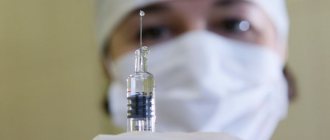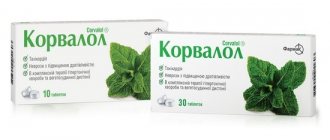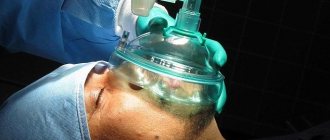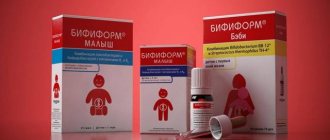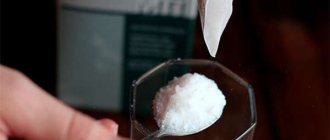General anesthesia used in children can have many consequences. The child's body grows and develops very quickly, and any interference with the central nervous system can negatively affect the child's development. This article discusses the main complications that can develop after surgery using general anesthesia.
General anesthesia
Preparing for general anesthesia in a child
Based on the nature and extent of the impact, anesthesiologists distinguish between “major” and “minor” anesthesia. In the first case, stronger and longer-acting drugs are used, and the patient is connected to an artificial respiration apparatus; the second is short-term and is used for short operations, while the patient retains the ability to breathe independently.
In addition, depending on the method of anesthesia, it is divided into:
- Intramuscular - an anesthetic (usually Ketamine) is injected into a muscle. This method does not allow one to accurately predict the duration of its action and is associated with increased risks of postoperative complications, and therefore in modern anesthesiological practice it is used less and less in favor of other types.
- Intravenous - medications are administered by drip into a vein.
- Inhalation (hardware-mask) - the patient inhales vapors of drugs through a mask. It is this type of general anesthesia that is most often used during operations on children. It is often combined with local anesthesia.
Regardless of the method of administering the anesthetic, if the operation is planned, careful preparation is carried out in advance. The baby will be carefully examined, the necessary tests will be taken (general blood and urine tests, blood coagulation studies, ECG, etc.), medical history and family history will be studied, and drug therapy will be prescribed aimed at physiological and mental preparation of the patient for the upcoming anesthesia, in particular sedatives and hypnotics are prescribed to reinforce the effect of the upcoming anesthesia.
Against the background of infectious and inflammatory processes (for example, during the development of ARVI and within 1-2 weeks after recovery) and exacerbation of chronic diseases, surgical interventions are not performed and general anesthesia is not used - all manipulations in this case are delayed until the child has completely recovered or until period of remission.
On the eve of the operation, a cleansing enema is performed (as an alternative, a diet and laxatives are prescribed) and catheterization of the bladder (that is, emptying it). 6 hours before the start of the manipulation, the child should not be fed; 4 hours before the start of the procedure, the child should not be given any liquid! The first step helps prevent the child from involuntary bowel movement during the operation, the second prevents the possible entry of stomach contents into the respiratory tract and suffocation.
Thus, even at the preparatory stage, doctors reduce to an absolute minimum the risk of complications during and after the operation. But, unfortunately, it is impossible to completely exclude it.
Before surgery
The main task of the anesthesiologist is to select the most effective drug, the use of which is associated with minimal risk of adverse consequences for the patient’s body. Currently, there are various types and methods of anesthesia, and medical scientists continue to conduct research in this direction and improve the drugs used.
In a state of anesthesia, a person completely loses control over what is happening. Therefore, it is necessary not only to select the most effective and safe painkiller, but also to properly configure the person psychologically. Before an operation using anesthesia, the patient is often overcome by understandable fears: will he wake up at all, what will the consequences be, how will the anesthesia affect his future life? Anesthesiologists claim that the likelihood of adverse effects of anesthesia on the human body is minimal.
Why general anesthesia is dangerous for children: risks and consequences
It should be noted that the greatest responsibility in such cases lies with the anesthesiologist. Of course, the surgeon must have all the necessary skills to operate on children. But if the anesthesiologist does not have a sufficient level of professionalism, then nothing else matters. Therefore, you only need to worry about having a good specialist. He selects a combination of drugs used for anesthesia and sets the optimal dosage. The result of such anesthesia is the child's unconscious stay for a certain period necessary for the surgeon's work, and a favorable postoperative outcome.
In modern practice, drugs are used that have stood the test of time and practice on adult patients and only after that were approved for use in children. They act for a strictly defined period of time, have no serious side effects and are quickly eliminated from the body. Thanks to improvements in the drugs used in anesthesia, the child recovers from anesthesia very quickly (within 15-30 minutes) and can immediately move and eat.
And yet, cases of intolerance do occur. It is possible to foresee non-acceptance of certain medicinal substances used in anesthesia only if the patient or his closest blood relatives have previously had similar reactions to medications.
In extremely rare cases, as a result of such intolerance, anaphylactic shock develops (a very life-threatening condition) or malignant hyperemia (a sharp increase in body temperature to 42-43 o C - as a rule, it is based on a hereditary predisposition). Also among the possible complications are cardiovascular failure (impaired blood supply to tissues and organs), respiratory failure (impaired gas exchange processes in the lungs), aspiration (reflux of stomach contents into the respiratory tract). When carrying out certain manipulations (placement of catheters on the veins or bladder, tracheal intubation, insertion of a gastric tube), mechanical trauma cannot be excluded.
In addition, some studies suggest that general anesthesia in children damages neurons in the brain and leads to cognitive impairment, that is, impairments in memory processes: children become more distracted, inattentive, and have poorer learning and mental development for some period after surgery , attention deficit hyperactivity disorder often occurs. But, firstly, the likelihood of such consequences is highest when using intramuscular anesthesia (or rather the already mentioned Ketamine), which is practically not used for children today. Secondly, the validity of such conclusions still remains not fully proven. Thirdly, children under 2 years of age are at greater risk. Fourthly, these phenomena are temporary, and the operation is carried out in connection with real problems with the child’s health. That is, the need for general anesthesia outweighs the likelihood of temporary consequences.
Moreover, it should be understood that serious consequences of general anesthesia actually occur in practice extremely rarely (in 1-2% of cases, or even less often), in exceptional situations. Even if the child falls into this special category of patients, the specially trained medical staff who are involved in the operation will provide him with qualified assistance in a timely manner. In addition, throughout the entire operation, from the first minute until another 2 hours after its completion, the child is under strict medical supervision. To monitor the patient’s condition, modern medical technology is used to keep vital signs under control: pulse, heartbeat and heart function, breathing and oxygen/carbon dioxide levels in exhaled air, blood pressure, depth of sleep, degree of muscle relaxation and pain relief, temperature body, etc., etc. The surgeon always pays attention to the condition of the skin and mucous membranes of the person being operated on. All this allows you to eliminate possible risks at the stage of the first signs of their likelihood.
The state of anesthesia is completely controlled by doctors, and the patient is under complete control and supervision.
Therefore, parents should not worry too much. It should be understood that general anesthesia is an ally that helps the baby get rid of a real health problem in the best, most painless way. Moreover, if necessary, it can be repeated several times.
Memory recovery
With deep and prolonged anesthesia, there is often a need to stimulate brain activity. Restoring memory after anesthesia sometimes becomes an important task in the postoperative period. For this purpose, elementary exercises will be quite effective.
The most effective way is to conduct a conversation with a clear formation of your thoughts. If dialogue is not possible, then such exercises can be done in front of a mirror, talking out loud. A good training method is solving crosswords and puzzles, and solving simple logic puzzles. One of the recommended methods is reading a book in the morning or afternoon with a detailed analysis of what you read before going to bed. You can remember small details, try to translate the plot into reality, put yourself in the place of the hero, etc. If you don’t have an interesting book at hand, then you can remember something that you once read before.
Carrying out various calculations is recognized as useful training, and you can count anything: from your previous life, what you saw outside the window, etc. Such exercises help restore memory and concentration. After discharge from the hospital, such training is not limited at all. When traveling in public transport, so many events happen outside the window that it is not difficult to come up with interesting statistics.
Proper nutrition also plays an important role in normalizing brain activity. Bitter chocolate is very useful for stimulating brain function, because... it stimulates the production of endorphins, which have a positive effect on memory. It is recommended to add almonds, walnuts, fruits, and vegetables to the diet. Positive results are found in tincture of rowan bark and clover decoction. To restore memory, it is advisable to consume blueberries.
Any surgical intervention is an extreme circumstance for a person. General anesthesia is an element that helps during surgery, but complicates life immediately after it, and therefore it is advisable to quickly get rid of its consequences. With proper restoration measures, its effect on the body can be completely neutralized in a short period of time.
General anesthesia for a child up to one year old
Often, doctors prefer to delay surgical procedures that require general anesthesia in children as long as possible, if time is of the essence. In each individual case, depending on the state of health and the existing problem, the most favorable period for such treatment is determined.
General anesthesia for infants and children under one year of age entails higher risks, since the main systems and organs of the baby (in particular the brain) continue to develop and remain vulnerable to various factors. However, depending on the diagnosis, it is not always possible to wait. And in this case, parents should understand that general anesthesia for the baby will cause much less harm than the absence of the necessary treatment.
Otherwise, everything stated above is also relevant for this age category of patients. The greatest difficulty for parents is the “hunger pause” before anesthesia: if the child is breastfed, then he cannot be fed 4 hours before the operation; artificial patients are not given anything for 6 hours. And the doctors will take care of the rest.
A little about brain training
It is necessary to stimulate the functioning of the brain. For this, various logic problems, learning some poems, memorizing something can help. If you don’t have a collection of poems at hand or have nowhere to get logic puzzles from, then you can at least try to memorize something. An excellent way to train your memory is to solve crosswords and puzzles.
If it becomes difficult for a person to have a conversation with someone, to formulate thoughts, it is worth talking in front of a mirror, reading aloud. This will not give an immediate effect, but over time it will help restore skills to their previous level.
General anesthesia for children for dental treatment
General anesthesia is also supported by the fact that there are practically no absolute contraindications to its use (with the exception of the use of certain medications and parental disagreement). In certain cases, it is recommended to use it even during certain diagnostic examinations or, for example, during dental treatment. Of course, this is not a type of anesthesia that should be used inappropriately. But in some cases, it allows you to carry out the necessary dental procedures in the best, highest quality manner and at the same time save the child and his family from a lot of suffering.
Experts say that there is no reason to be afraid of general anesthesia during dental treatment in children. But such treatment can only be carried out in specialized clinics that have the appropriate licenses, equipment and personnel specially trained for this.
For whatever reason, a child is under general anesthesia, he will not feel any discomfort from the procedure if at the moment of “switching off” his consciousness and returning to reality, someone close to him is nearby. For the rest, just trust the professionals and don’t worry about anything! Everything will be fine!
Especially for - Ekaterina Vlasenko
Anesthesia is the artificial introduction of a person into deep sleep using special drugs. Reversible inhibition of the central nervous system occurs with loss of consciousness, relaxation of skeletal muscles and partial loss of reflexes. Such anesthesia allows you to safely and effectively perform an operation of any complexity, but every patient should be aware of the possible complications and consequences.
About a healthy lifestyle
A healthy lifestyle is also very important. The body needs physical activity. Even basic gymnastics will be very helpful. People who have undergone anesthesia should spend more time in the fresh air.
As for bad habits, such as smoking, drinking alcohol, drugs, then it’s worth stopping. All of the above will negatively affect the process of memory recovery.
Many factors influence brain performance, and one of them is sleep. It is very important for a person to get enough sleep so that the process of memory restoration after anesthesia occurs successfully. In this case, you should not use sleeping pills.
For good brain function, which is important for memory restoration, it needs to be well supplied with blood. To improve blood circulation, you need to move a lot. It is important that a person does not lack oxygen, so long walks in the fresh air are a very important element in the process of memory restoration.
Technique for mask anesthesia for adults and children
Anesthesia can be administered intravenously, intramuscularly or inhalation. The mechanism of action of the latter method is to inhale gaseous substances (ether, fluorothane, pentran, nitrous oxide). It can be performed by the endotracheal or endobronchial method (when substances are delivered directly into the respiratory tract through a tube), or as mask anesthesia (involves inhaling a mixture of gases through a special mask).
The combination of anesthetics is selected by the anesthesiologist individually depending on the patient’s condition and the type of medical procedure. Their main goal is to minimize the body’s negative reaction to aggressive medical manipulation. Anesthesia should not only induce sleep, but also reduce the severity of the body's automatic reactions and relax the muscles.
After taking a comfortable position, the doctor brings a face mask to the patient’s face. After about a minute, the substances begin to act.
Advice:
In the intermediate stages of falling asleep, the child may become disoriented, try to sit up, breathe rapidly or wheeze. This is considered a normal reaction of the body to immersion in anesthesia.
In pediatric dentistry, mask anesthesia is often used for long-term medical procedures, because it causes a quick effect and is easily regulated (the child will wake up only after the supply of the gas-narcotic mixture is stopped). For most often I use substances such as fluorotane and nitrous oxide, which enter the lungs through inhalation. for children it is preferable only in some cases: large and complex operations, plastic surgery of the lower jaw, interventions on it.
What is the problem
At its core, anesthesia, or anesthesia, is the process of artificially inhibiting the reactions of the central nervous system to pain during a surgical operation. This depression of the nervous system is reversible and is expressed in the loss of consciousness, sensitivity and reflex reactions, as well as a significant decrease in muscle tone.
Anesthetic substances are introduced into the human body to suppress synaptic transmission of excitation to the central nervous system, which is achieved by blocking afferent impulses. At the same time, contacts in the cortical-subcortical system change, and dysfunction of the intermediate, mid and spinal cord occurs. These processes occur only during the period of anesthesia, but after the cessation of its influence everything should return to its previous course.
The human body perceives anesthetic substances differently, and therefore a number of drugs of different classes are used, and quite often a combination of several drugs is administered. The choice of their type and dosage is made by an anesthesiologist after conducting the necessary studies of individual sensitivity. In addition, depending on the extent and duration of the surgical operation, anesthesia can be of different depths: superficial, light, deep or very deep.
When prescribing a general anesthesia regimen, methods for exiting artificial retardation after completion of the operation are immediately analyzed. Naturally, the intense effect on the central nervous system, although reversible, causes significant consequences. The state after anesthesia depends on the characteristics of the body, the type of anesthetic and its dosage, and the duration of the effect.
With proper anesthesia, the human body is capable of fully recovering on its own, but this requires some time. The doctor’s task is to ensure complete and rapid rehabilitation of all temporarily suppressed functions. Immediately after the operation, the patient is sent to the intensive care unit, where primary recovery measures are carried out. The duration of resuscitation depends significantly on the person’s age and the presence of diseases.
Contraindications and possible complications
Indications for the use of this type of pediatric anesthesia include therapeutic and diagnostic manipulations in ENT practice, as well as those that require disruption of tissue integrity (biopsy, puncture), endoscopic examinations of the gastrointestinal tract, operations on the abdominal organs, and suturing wounds. In dentistry, it is used only for indications: the child’s inadequacy due to fear, a large amount of work.
The reasons for searching for an alternative option are considered to be the refusal of the parents, the need for a major operation, complications from mask anesthesia in the past, and the serious condition of the child.
Indications for mask anesthesia in adult patients include the presence of trauma, including burns, myocardial infarction, and the need for transport immobilization.
Contraindications for adults:
The most common complications of anesthesia, including during dental procedures, are respiratory failure (hypoventilation), vomiting, regurgitation of gastric contents - passive entry of masses into the esophagus, oral cavity, anaphylaxis (allergic reaction), hypotension (lowering blood pressure). But any body system can fail.
Problems with the respiratory system:
- suffocation due to oxygen starvation, obstruction of the airway;
- tongue retraction (can also occur after surgery);
- laryngospasm due to closure of the vocal cords;
- bronchospasm (air cannot escape through the narrowed passage of the alveoli).
To prevent and minimize, use a supply of humidified oxygen and strictly adhere to anesthesia technology.
Circulatory problems:
- disturbance of heart rhythm, blood pressure;
- increased bleeding;
- heart failure.
Most complications in children occur during the awakening stage, disrupting vital functions. Most often they manifest themselves in the form of depression of consciousness, breathing, and blood circulation due to the residual effect of narcotic substances, metabolic disorders, and a decrease in circulating blood volume.
Advice:
Before starting general anesthesia for a child, the dentist must conduct a general, biochemical blood test, a test for coagulation and platelets, blood group and Rh, as well as a urine, stool, ECG test and obtain a pediatrician’s opinion on the state of health and the absence of contraindications.
To prevent problems from arising, immediately after emerging from anesthesia, the patient should periodically take deep breaths and exhales, move his legs and arms.
Instructions
- It all depends on the type and dosage of anesthesia; activity of enzymes that break down narcotic substances; on the type of nervous system of the patient; duration and extent of surgical intervention. General health and age also matter a lot. Young people get on their feet much earlier than older people.
- There are early and late complications after anesthesia. Coming out of it is often accompanied by confusion of consciousness. Disoriented in time and space, the patient has difficulty understanding where he is and what is happening to him. There are even hallucinations that disappear quickly enough.
- Other side effects last for many hours. This is primarily trembling, fever. The patient feels feverish, and a few minutes later he shivers from the cold. The caregiver must quickly respond to these temperature changes: either cover the patient, or take off the blanket and place a cool, damp cloth on the forehead.
- Another common complication from all types of anesthesia is painful nausea, leading to vomiting. Because of it, surgical sutures can come apart, especially after ophthalmic, otolaryngological operations, or abdominal operations. Therefore, it is necessary to give the patient an antiemetic drug.
- As the anesthesia wears off, the pain due to surgically injured tissue increases. Blood pressure may increase and tachycardia may appear. To alleviate the condition, the patient is periodically administered doses of painkillers.
- After anesthesia, you really want to drink, and smokers also want to smoke. But these requests cannot be fulfilled. A sip of water can cause severe vomiting. And taking a puff from a cigarette causes clouding and even loss of consciousness. You can only moisten the patient’s lips with a moistened napkin.
- If the sensitivity of some part of the body is lost, there is no need to be afraid of it. The muscles may not obey, coordination of movements may be impaired - this will also pass when the anesthetic drug is completely removed from the body.
- The later effects of anesthesia are more complicated. They usually make themselves known after weeks. Some people experience headaches that are so severe that they cannot be compared with the pain that occurs immediately after surgery. Others suffer from dizziness, others from insomnia, and others from leg cramps. A therapist who should be contacted immediately will help you get rid of them.
- The heart can give a late reaction to anesthesia with pressure drops and tachycardia. Sometimes there are problems with the liver and kidneys, because they are the ones that remove narcotic substances.
- But more often memory deteriorates somewhat, especially after heart surgery. However, it usually recovers within a week. Much less often, memory disorders can persist for a year or longer. Nootropic drugs Cavinton, Cerebrolysin, Phezam, etc. help restore brain function faster.
- Sometimes before and after surgery a person is overcome by a difficult to control feeling of fear. “Panic attacks” appear, which greatly undermine the nervous system. To get out of this state, you cannot do without a psychotherapist.
Recovery after anesthesia is considered an important stage of surgical treatment. Each human body has individual sensitivity to the effects of anesthetics. Some people recover from anesthesia within half an hour after it ends, while others require considerable time and medical attention. In any case, the myths about the terrible danger of general anesthesia cannot be trusted, but it is better to completely trust the experience of specialists. With the correct dosage and all necessary measures, the body fully recovers from the action of anesthetic substances in a short time.
Consequences of mask anesthesia
In the scientific press, publications by practicing physicians about the effect of mask anesthesia on the cognitive system, especially in children, are increasingly appearing. Some patients suffer from impaired memory, thinking, and concentration. In young patients, neuralgic abnormalities and changes in behavior are diagnosed. But if anesthesia is performed by a qualified doctor with full compliance with technology, the risk of serious complications is minimal.
Attention!
The information on the site is presented by specialists, but is for informational purposes only and cannot be used for independent treatment. Be sure to consult your doctor!
Surgery under general anesthesia in a person of any age causes anxiety. Adults recover from anesthesia in different ways - some recover from the procedure easily, while others recover poorly, taking a very long time to recover. Children, in addition to a general impairment of well-being, are not aware of what is happening and cannot adequately assess the situation, so surgery under general anesthesia can become very stressful. Parents worry about what consequences anesthesia will entail, how this will affect the child’s well-being and behavior, and what care the children will need after waking up.
Recovery period after surgery under general anesthesia
Something More About Brain Exercises
You can remember your past place of residence: an apartment, a house. It is worth remembering both general points and small details. For example, you can remember what the shape of the door handles was, what patterns were on the curtains and other similar little things. This will train your memory.
You can “rewind” days, weeks, months in your head. Moreover, you can do this in different ways: you can skip the day from beginning to end, or you can skip it the other way around, starting from the end. It can be difficult to scroll through the weeks at first. However, over time, it will become easier and easier to remember larger and larger periods of time.
You can recall vivid events in your memory. It could be some kind of trip. We must try to remember every day from this journey. Remembering the interior of a hotel room will help, for example, you can try to remember what color the curtains were, how high the ceiling was.
Try to remember your school days, everyday work, lectures at the university and much more. Such simple gymnastics for memory can be very useful; it is not at all complicated, but it is better to do it regularly.
For some this may seem boring. Then it’s worth looking for some interesting logic puzzles. There is a lot of similar literature, and if you wish, you can find something that will not only be useful, but also entertaining.
Mathematical calculations can be a good exercise for the brain.
This is very convenient, because not everyone has changed their place of residence, not everyone has any vivid memories, and almost everyone can count. Practicing such a mental gymnast, as well as practicing logical puzzles, will help restore memory after anesthesia. To some, calculations may seem uninteresting in themselves, so such people can do them while solving some practical problems, for example, when calculating the required number of bricks for a planned house.
You can practice many types of memory improvement not only at home, but also on public transport or somewhere else. At first, it may be difficult not to focus entirely on mental exercises. However, over time, a person can learn to do such gymnastics without concentrating on it 100%.
Helping your baby after recovery from anesthesia
Recovery from anesthesia occurs under the strict supervision of an anesthesiologist and begins immediately after stopping the administration of the anesthetic. The specialist carefully monitors the child’s vital signs, assessing the effectiveness of breathing movements, blood pressure levels and the number of heartbeats. After making sure that the patient’s condition is stable, he is transferred to the general ward. It is advisable that the parents wait in the child’s room - the unpleasant state after anesthesia usually frightens children, and the presence of a loved one will help calm them down. In the first hours after waking up, the baby is lethargic, lethargic, and his speech may be slurred.
Girl in the ward after surgery
When using modern drugs, their elimination period lasts no more than 2 hours. At this stage, you may experience unpleasant symptoms such as nausea, vomiting, dizziness, pain in the surgical area, and fever. Each of these symptoms can be relieved by taking certain measures.
- Nausea and vomiting are common side effects of general anesthesia. It has been noted that the likelihood of vomiting is associated with blood loss - with extensive bleeding, the patient vomits in very rare cases. If a child has nausea, it is not recommended to eat for the first 6-10 hours after surgery; liquid can be taken in small quantities so as not to provoke a new attack of vomiting. As a rule, relief occurs a few hours after recovery from anesthesia. If the child's condition has deteriorated significantly and vomiting does not bring relief, you can ask the nurse to give an injection of an antiemetic drug.
- Dizziness and weakness are the body’s natural reaction to anesthesia in the first hours after waking up. It takes some time to recover and it will be better if the child sleeps for a few hours. If for one reason or another sleep is impossible, you can distract your baby with cartoons, a favorite toy, an interesting book or a fairy tale.
- Trembling is a consequence of impaired thermoregulation. It is recommended to arrange a warm blanket in advance to help keep your child warm.
- An increase in temperature is usually observed on the first day after surgery. This reaction of the body is considered normal when the values do not exceed subfebrile levels. An elevated temperature a few days after surgery suggests the development of complications and requires additional examination.
A nurse measures a girl's temperature after surgery
General anesthesia has the greatest impact on babies under one year of age. Infants have developed a clear diet and sleep schedule, which becomes confused after anesthesia - children can confuse day and night, staying awake at night. In this case, only patience will help - after a few days or weeks the baby will return to his usual routine on his own.
In rare cases, parents observe that their child “fell into childhood,” that is, he began to perform actions that are not typical for his age. You don’t have to worry about this; most likely, this is a temporary phenomenon and will go away on its own.
Some children, after surgery using general anesthesia, sleep poorly, are capricious, and refuse to eat. Some rituals that should be performed every day before bed can help your child fall asleep. This could be a glass of warm milk, interesting fairy tales or a relaxing massage. You should limit watching TV - frequent changes of pictures provoke excitement of the nervous system, even the most familiar harmless cartoons can increase sleep disturbances.
Troubleshooting
Postoperative rehabilitation associated with general anesthesia and other features of surgical treatment requires solving the following important problems:
- Respiratory rehabilitation. Some anesthetics, as well as neurogenic factors, impair pulmonary function, leading to postoperative respiratory problems. Restorative measures consist in the correct positioning of the operated person: he is placed in a supine position with his head raised, conditions are created for his movement in bed. Every 1.5-2.5 hours breathing exercises are performed, incl. inhalation with the creation of resistance using a spirometer, as well as exhalation through water in a container.
- Blood venous stagnation in the extremities. This phenomenon occurs when there is a forced violation of muscle tone, which poses a risk of thrombosis. Restorative procedures are based on taking blood thinners. In addition, special bandages are used for the calf muscles, which simulate physiological muscle activity.
- Normalization of digestive function. Temporary disruption of intestinal and gastric motility is considered a natural reaction of the body to extreme influences. Normalization of peristalsis occurs independently, usually within 3-4 days, but the task of complete rehabilitation is to help the body recover. An important condition is the provision of a special postoperative nutritional regimen.
Read also: Husband is a binge alcoholic, what to do forum
Feeding a child after anesthesia
If the baby feels well, sleeps well, and is not bothered by fever, nausea or vomiting, then doctors advise returning to normal life as soon as possible. Early activation of the patient promotes rapid recovery and prevention of postoperative complications. After 5-6 hours, doctors may allow your child to eat. The food should be light - it could be vegetable soup, jelly with crackers or toast, porridge with water. Infants receive mother's breasts or formula milk.
In the absence of vomiting, drinking plenty of fluids will help you recover quickly. Pure still water, compotes, fruit drinks, and teas are most suitable. Juices and sweet carbonated drinks are not recommended for frequent drinking as they contain large amounts of sugar.
Proper psychological preparation, the presence of loved ones and compliance with all doctor’s recommendations will help the child survive the postoperative period more easily. The child’s body has the ability to recover quickly, and within a few days the baby will feel much better than on the first day after the operation.


